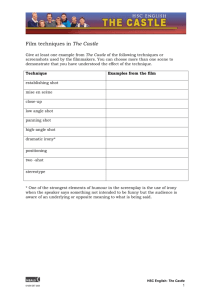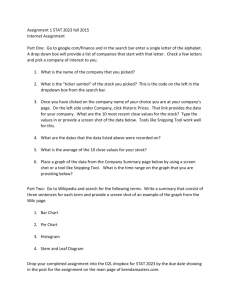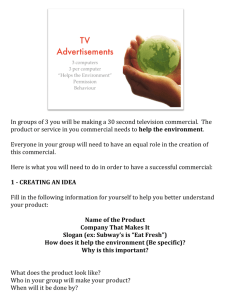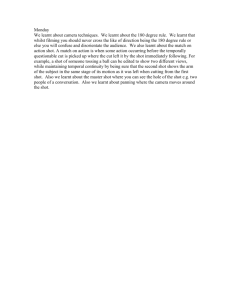Camera Techniques - Digital Safari Academy
advertisement
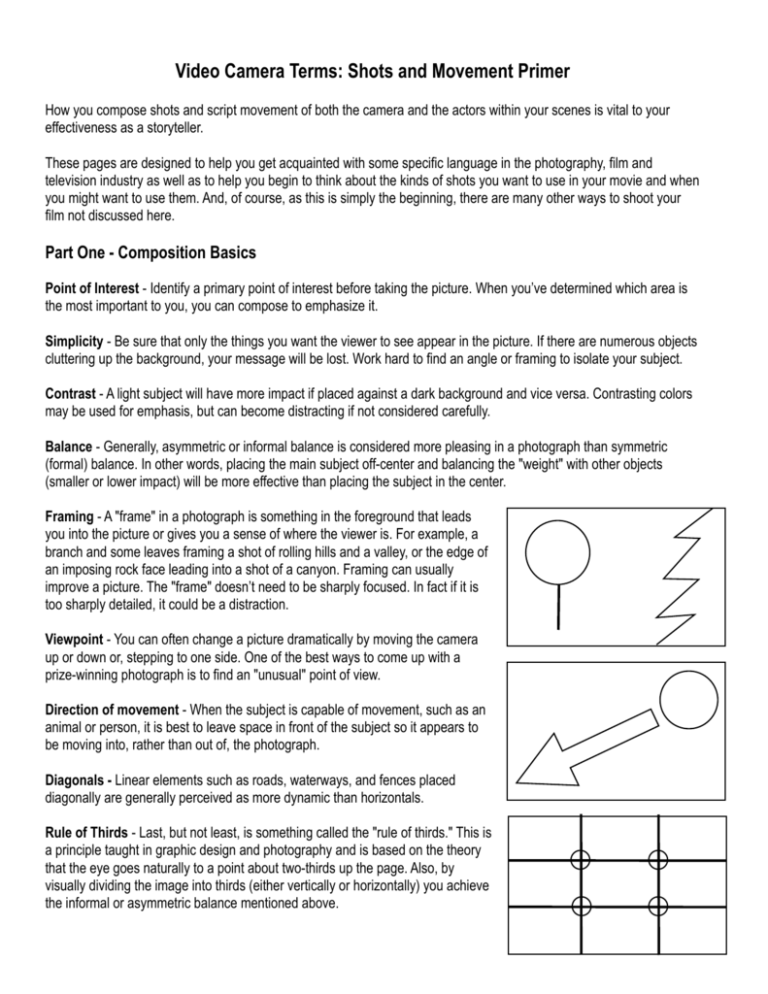
Video Camera Terms: Shots and Movement Primer How you compose shots and script movement of both the camera and the actors within your scenes is vital to your effectiveness as a storyteller. These pages are designed to help you get acquainted with some specific language in the photography, film and television industry as well as to help you begin to think about the kinds of shots you want to use in your movie and when you might want to use them. And, of course, as this is simply the beginning, there are many other ways to shoot your film not discussed here. Part One - Composition Basics Point of Interest - Identify a primary point of interest before taking the picture. When you’ve determined which area is the most important to you, you can compose to emphasize it. Simplicity - Be sure that only the things you want the viewer to see appear in the picture. If there are numerous objects cluttering up the background, your message will be lost. Work hard to find an angle or framing to isolate your subject. Contrast - A light subject will have more impact if placed against a dark background and vice versa. Contrasting colors may be used for emphasis, but can become distracting if not considered carefully. Balance - Generally, asymmetric or informal balance is considered more pleasing in a photograph than symmetric (formal) balance. In other words, placing the main subject off-center and balancing the "weight" with other objects (smaller or lower impact) will be more effective than placing the subject in the center. Framing - A "frame" in a photograph is something in the foreground that leads you into the picture or gives you a sense of where the viewer is. For example, a branch and some leaves framing a shot of rolling hills and a valley, or the edge of an imposing rock face leading into a shot of a canyon. Framing can usually improve a picture. The "frame" doesn’t need to be sharply focused. In fact if it is too sharply detailed, it could be a distraction. Viewpoint - You can often change a picture dramatically by moving the camera up or down or, stepping to one side. One of the best ways to come up with a prize-winning photograph is to find an "unusual" point of view. Direction of movement - When the subject is capable of movement, such as an animal or person, it is best to leave space in front of the subject so it appears to be moving into, rather than out of, the photograph. Diagonals - Linear elements such as roads, waterways, and fences placed diagonally are generally perceived as more dynamic than horizontals. Rule of Thirds - Last, but not least, is something called the "rule of thirds." This is a principle taught in graphic design and photography and is based on the theory that the eye goes naturally to a point about two-thirds up the page. Also, by visually dividing the image into thirds (either vertically or horizontally) you achieve the informal or asymmetric balance mentioned above. Part Two —Basic Camera Shot s Images from - http://www.aber.ac.uk/media/Documents/short/gramtv.html Key - XLS: Extreme Long Shot; LS: Long Shot; MLS: Mid Long Shot; MS: Medium Shot; MCU: Medium Close Up; CU: Close Up; BCU: Big Close Up; XCU: Extreme Close Up Long Shot – A shot that shows the complete human figure from head to toe. Extreme Long Shot – A shot that shows objects from a great distance. (Often used as an establishing shot to show the figure within the context of the scene’s setting.) Mid Long Shot – A shot that shows the human figure from the ankles to the head. Medium Shot– A shot that shows the human figure from the waist up. Medium Close Up – A shot that show the human figure from the chest up. (Often used for the shooting of two actors – two shot) Close Up – A shot that shows the human figure from the shoulders up. Big Close Up – A shot from the forehead to the chin. (Used to focus attention on feelings or reactions. The subject is separated from the context of the scene.) Extreme Close Up – A shot showing only the eyes and nose. Part Three – Shot Angles Images from - http://www.aber.ac.uk/media/Documents/short/gramtv.html High Angles may create a sense of power in the viewer, a sense of separation from the scene, or a diminished view of the character. Low Angles may create a sense of exaggerated importance, strength and size and a loss of power in the viewer. Eye Level shots can be used to maintain a sense of reality in relationship to the character and should be used when trying to present an unbiased view of the subject matter. Part Four – Camera and Lens Movement Zoom – In zooming in the camera does not move; the lens is focused down from a long shot to a close up whilst the picture is still being shown. The subject is magnified, and attention is concentrated on details previously invisible as the shot tightens (contrast tracking). It may be used to surprise the viewer. Zooming out reveals more of the scene (perhaps where a character is, or to whom he or she is speaking) as the shot widens. Zooming in rapidly brings not only the subject but also the background hurtling towards the viewer, which can be disconcerting. Pans involve pivoting the camera left to right atop the tri-pod. In directing you refer to “pan left” or “pan right” Following pan – The camera swivels to follow a moving subject. A space is left in front of the subject: the pan 'leads' rather than 'trails'. A pan usually begins and ends with a few seconds of still picture to give greater impact. The speed of a pan across a subject creates a particular mood as well as establishing the viewer's relationship with the subject. Surveying pan – The camera slowly searches the scene without following the subject: may build to a climax or anticlimax Tilt – A vertical movement of the camera upon the tripod. Crab – The camera moves right or left. Ideally this is done on a track and not with hand held shots (which may look jerky). We can approximate this with our wheeled tripod. Tracking (dollying) – Tracking involves the camera itself being moved smoothly towards or away from the subject at a fixed focal length. Tracking in (like zooming) draws the viewer into a closer, more intense relationship with the subject; moving away tends to create emotional distance. Tracking back tends to divert attention to the edges of the screen as more detail is revealed.



